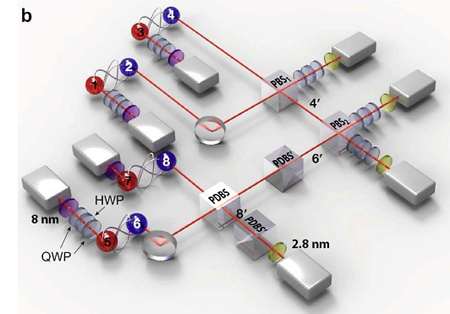
Chinese Scientists Perform Topological Quantum Error Correction
Prof. PAN Jianwei and his colleagues CHEN Yu'ao and LIU Naile from the Hefei National Laboratory of Physics at the Microscale, working together with scientists in Australia and Canada, have successfully demonstrated a topological quantum error correction code for the first time. This marked a significant breakthrough in scalable fault-tolerant quantum computing. The paper was published in Nature as an article on Feb. 23, the issue commemorating the 100th anniversary of the birth of Alan Mathison Turing, the "Father of Computer".
Quantum computer is every scientist's dream due to its powerful computing ability over classical ones. However, a key obstacle to its realization – decoherence effect – has long baffled the scientists. That is to say, it has been impossible to avoid mistakes during the computing process as an unavoidable result of quantum computer's coupling with its environment. The error probability in every step has to be controlled under 10-5 orders, which is out of the reach of the experiments today.
In recent years, a brand new concept known as " topological error correction" have been put forward, i.e. using the topological feature of quantum in quantum correction, thus increasing the highest tolerable error probability in logical operation by three orders to 10-2 orders. Topological quantum error correction schemes greatly ease the demand on operation precision to a level attainable by present-day experimental techniques. Topological quantum error correction is therefore the quantum computing scheme with the highest error tolerance rate in today's world, and it makes scalable fault-tolerant quantum computing much easier.
Funded by Chinese Academy of Sciences, Ministry of Education and National Natural Science Foundation of China, PAN Jianwei and his team increased the brightness of two-photon states by 4-5 times, and that of eight photon entangling by 200 times at least through innovative experimental techniques, making what had been impossible a reality in mere 80 days. Moreover, researchers have also designed a special eight-photon interferometer to filter out noise and successfully created a topological eight-photon cluster state, which was used as a core resource in quantum computing to realize topological quantum error correction.
The research findings show single bit errors can be corrected completely during topological quantum computing, and the effective error probability related to the protected quantum can be greatly reduced when every quantum bit is making errors at the same probability.
This research has marked a milestone in quantum computing by taking the first step in experimenting scalable fault-tolerant quantum computing. It will boost the development of quantum computing by laying a solid foundation for quantum computing in real meaning. Referees of Nature commented the research as "Very important proof of principle experiment performed in a heroic 80-day quantum optics experiment. The experiment was well-done and extremely challenging." Prof. James Franson was invited to write an article in "News & Views" to introduce this research. Many leading popular journals such as Physics World by Institute of Physics, have reported this experiment.

Descriptions: a Figure of Experiment Equipment (Image by USTC)

86-10-68597521 (day)
86-10-68597289 (night)

52 Sanlihe Rd., Xicheng District,
Beijing, China (100864)

